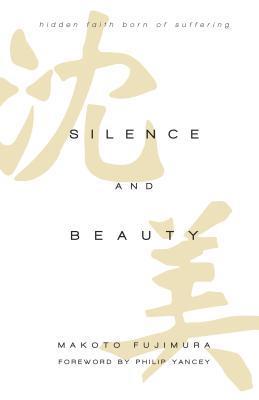
Silence and Beauty: Hidden Faith Born of Suffering, Makoto Fujimura (foreward by Philip Yancey). Downers Grove, IL: InterVarsity Press, 2016.
Summary: A “layered” reflection on Shusako Endo’s Silence by a Japanese-American artist that explores the Christian experience of persecution in Japan, and the connections between silence, suffering, and beauty, that may draw contemporary Japanese to faith.
It is said that you cannot judge a book by its cover. Yet my very first encounter with this book suggested I was in for something special as I looked at a cover with a pure white background, a couple of Japanese characters, and a translucent dust jacket with the the words “Silence and Beauty” superimposed on those characters. I opened the book to find inside papers that I believe are a work of the artist/author. And what I found between the covers was a profound reflection upon Shusako Endo’s Silence.
Makoto Fujimura is an internationally renown artist who paints in the ancient Japanese technique of nihonga, which involves the pulverizing of various minerals mixed into a binder and applied in as many as one hundred layers onto art papers. He begins his work by describing his encounter with Endo’s work having a similar “pulverizing” effect in his life as he encountered the suffering of Christian martyrs and the attempt to shame apostatizers by having them walk on fumi-e (bronze images of the crucified Christ, or the Virgin Mary). The novel revolves around Father Rodrigues, who struggles between martyrdom, and saving others from suffering by walking on fumi-e, and the interior struggle with the “silence” of God in the face of such suffering.
From here, Fujimura explores layers of meaning as he interweaves his own artistic journey, and the struggle to be faithful to Christ in an art world often hostile to faith. He also explores Japanese culture and the connections between “the chrysanthemum and the sword”, between kindness and cruelty, beauty and suffering, and how this has shaped Japanese consciousness, art, and literature. Along the way, he reflects on the paradox of the fumi-e, at once a symbol of shame, and yet by the very act of those who step on Christ, a proclamation of the cross. And with this, he uncovers a reality with which we often struggle but do not find easy to admit, living between faithfulness and denial. The fumi-e, a symbol of shame, becomes a symbol of hope, for Father Rodrigues, and for us.
I struggled at first in understanding what Fujimura was doing until I grasped that rather than a linear exposition of Endo’s work, this was a layered reflection, returning to the canvas again and again adding new insights and reflections to what he’d already written. Fujimura layers history, story, and biography together. Nagasaki was “Ground Zero” for the first martyrdoms of Christians in the Japanese persecution, the location of persecution in Silence, and the site of the second atomic bombing on August 9, 1945. Ground Zero was a church where many were worshiping. Fujimura interweaves his own “Ground Zero” experience of having a studio and a loft apartment in the shadow of the World Trade Center on 9/11 and the struggle with suffering, darkness and lament, and the paradox of beauty that may arise from these.
The book includes a summary of Endo’s book for those who have not read it. Fujimura suggests, and I would agree, reading Endo’s book first. I read Silence a number of years ago and want to re-read it, and perhaps re-read Fujimura’s book as well. He also discusses Endo’s relationship in two appendices to two other Japanese authors of note, Yasunari Kawabata and Kenzaburo Oe. There is a glossary of Japanese terms which is quite helpful, and which you want to have your thumb in as you read.
The book concludes with some thoughtful observations about Christian mission in Japan (which I think are also applicable in the West) that brings brokenness and beauty together, in place of a church that has often seem more focused on legalism. He speaks of the hunger for beauty in Japanese culture, the longing for liberation from fumi-e, and the power of the Christian message to bring this. These are his concluding words:
Endo shows that God speaks through silence. ‘Even if he had been silent, my life until this day would have spoken of him.’ In the mystery of silence and beauty God speaks through our broken lives facing our Ground Zero. In the layers revealed through the worn-smooth surface of a fumi-e is a true portrait of Christ; Japan’s unique hidden culture offers it as a gift to the world.
In Silence and Beauty, what Fujimura has done is explore those layers and revealed this gift.
Disclosure of Material Connection: I received this book free from the publisher. I was not required to write a positive review. The opinions I have expressed are my own.
Editor’s Note: Thank-you to Bob Trube for sharing his reviews with Emerging Scholars! Bob first posted the above review on Bob on Books. As some of you know, I gave time to reflecting upon Silence and Beauty and Silence this summer. With other commitments I have been unable to summarize my reflections in a blog post. Maybe I am still processing. Hoping to give this post attention in Spring 2017. In the meantime, please feel free to share your insights by commenting below. ~ Thomas B. Grosh IV, Associate Director, Emerging Scholars Network
Bob Trube is Associate Director of Faculty Ministry and Director of the Emerging Scholars Network. He blogs on books regularly at bobonbooks.com. He resides in Columbus, Ohio, with Marilyn and enjoys reading, gardening, choral singing, and plein air painting.

Leave a Reply